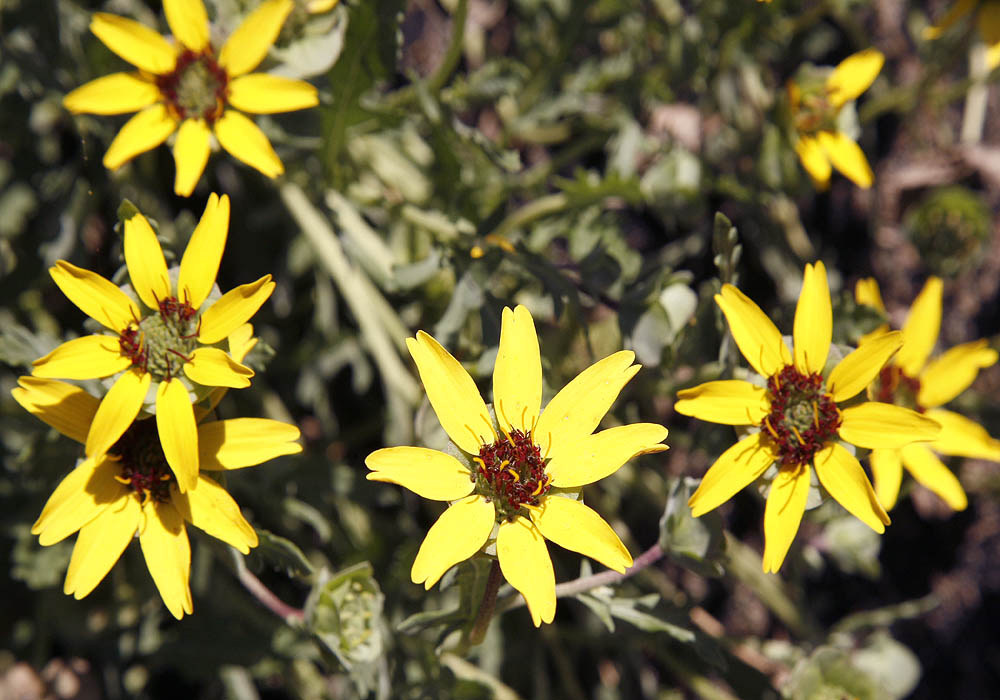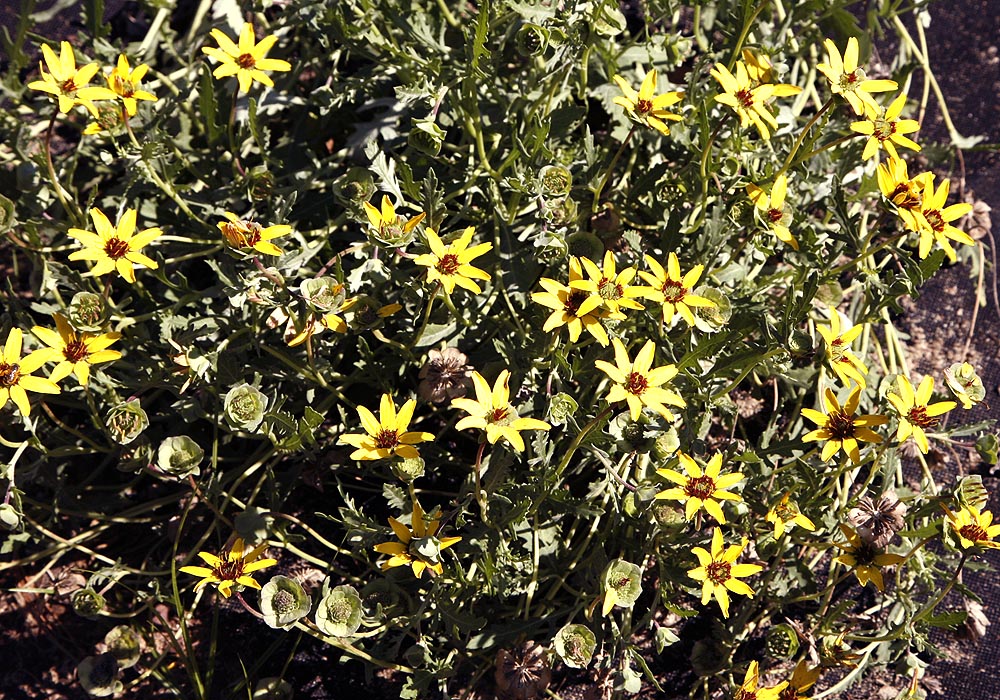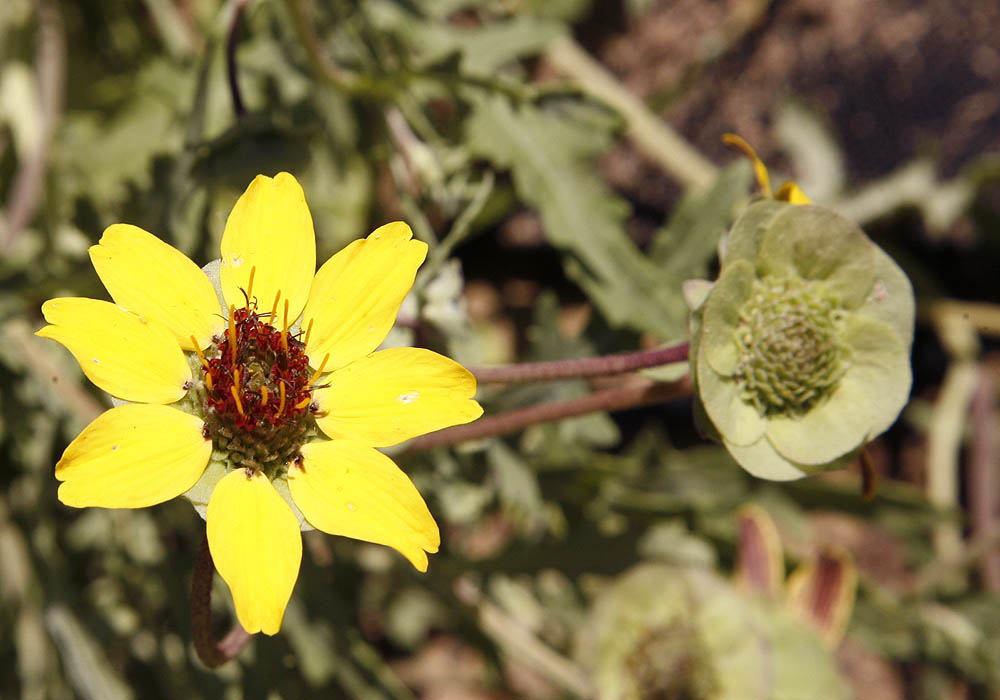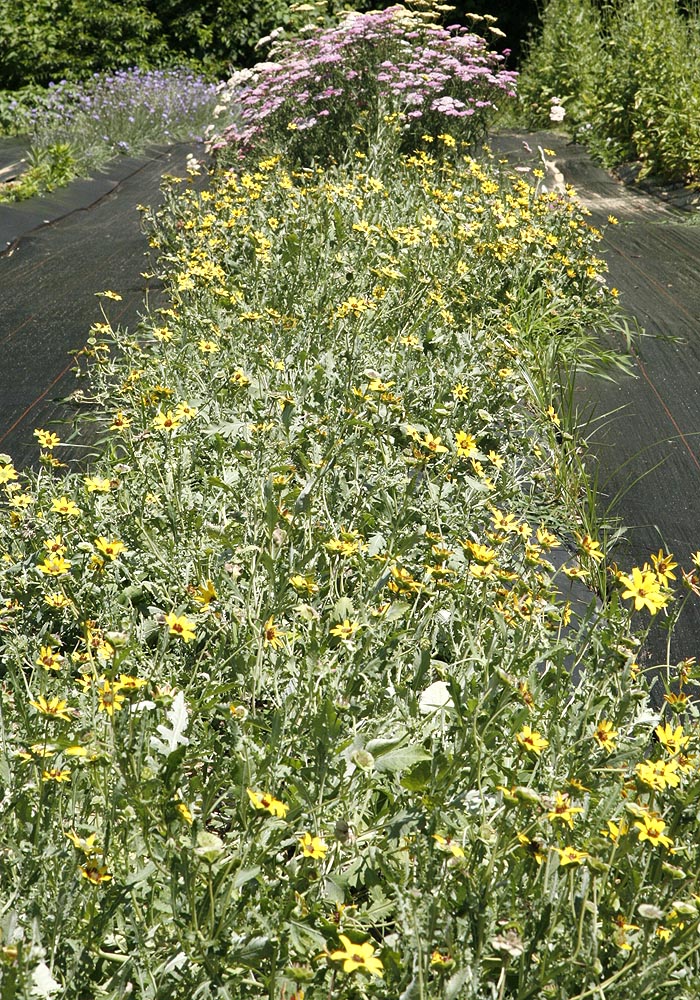A Native American perennial plant from the desert regions and higher mountain areas of North America. This tough little plant is hardy to zone 4 and comes back year after year to produce prolific numbers of bright yellow chocolate scented daisy like flowers. The aroma wafts across any garden for fairly long distances in the morning hours so don't go outside to work unless you have eaten as it can make you very hungry. It's the tiny stamens of this plant that produce the incredibly strong aroma, it also produces the same very bitter flavor of raw chocolate if eaten so be warned before you chew down on a flower, which are edible and can be used to flavor culinary dishes, with care.
Very easy to grow from seed this plant needs full sun, poor soil and little water to produce mounds of flowers all season long, which is unusual for a perennial. It will die back to the ground in cooler zones but in warmer ones it can stay green and flower all year long. Needs almost no maintenance once established and wildlife don't seem to eat it. What chocolate lover could resist?
Description of Chocolate Flower (Berlandiera lyrata).
Low growing native American perennial hardy to zone 4. In warmer zones it will stay green all year while 7a and above it will die back to the ground. Forms mounds of sprawling low growing leaves that are slightly grayish green above and more whitish on the underside with fine dense hairs. Leaves are long, oval in total shape but deeply lobed and cut almost to the central vein and fairly reminiscent of a dandelion leaf with long stems. They can be very variable in shape from deeply lobed to few if any lobes at all. All leaves are produced in multitudes in a basal rosette and then along stems up to 24 inches (61cm) long that can be either upright or sprawling along the ground. From these flower stalks arise; these are leafless and produced in profusion. The flowers can be up to 2 inches (5cm) in diameter and each sports eight Petals are roughly oval with bi-lobed ends. These are bright yellow on the upper surface while the underside has darker maroon stripes or long blotches. Petals are widely spaced and surround a green center with dark maroon bracts and stamens arranged in a circle between the two. It is these stamens that produce the strong chocolate aroma that is so characteristic of this plant.
Flowers only bloom in cooler temperatures so they tend to open at night but towards morning so the aroma of chocolate will sweep across the land carrying for fairly long distances. As temperatures rise young flowers will close and await the cool of evening to perhaps open again, or they may wait for the early morning. Mature flowers will begin to drop their petals. Flowers often last for several days opening and closing but rarely more than four days. Sometimes petals turn white before they fall but often they remain yellow. Without petals what remains still looks like a flower because the overlapping green bracts that were behind the petals form a beautiful rosette. There are three layers of these U shaped bracts with pointed ends that overlap rather like a rose. These are now surrounding a center that has turned brown after pollination. These green 'flowers' are what gives the plant the name lyreleaf green eyes. As the seeds mature some of the bracts drop leaving a single layer of bracts each of which has a single large flat seed before it. It is important to note that as a chocolate flower develops it produces the large green bract structure first and the petals form later as tiny thin pointed structures around the green center. At this stage it is only the difference in color from green to brown that differentiates the flower buds from the mature pollinated flower.
Plants usually bloom prolifically from early spring until the frost knocks them down which is unusual for a perennial that normally has a much shorter blooming period.
Growing Chocolate Flower (Berlandiera lyrata) from Seed.
Easy to grow from seed. Use a fine compost mix and do not fertilize. These plants prefer poorer soils. Keep compost barely moist and water sparingly once the seedlings sprout as they don't like a lot of water. Give plenty of sunlight. Can be started indoors at any time during the growing season or outdoors in well prepared area. Ensure weeds are carefully removed until plants are large enough to handle themselves then they usually beat out all but the toughest weeds. If starting in pots take care not to disturb the roots when transplanting as chocolate flowers produce a tap root and damage can cause strong reduction in growth until it is re-established.
For more information on starting seeds see our
General Growing Instructions.
Location and Care of Chocolate Flower (Berlandiera lyrata).
Needs full sun and well drained soil. Cannot tolerate any kind of wet or strongly moist soil and may cause roots to rot. Ideal for rockeries, areas with lots of gravel even gravel driveways. Can take some mild shade in warmer zones 8 or warmer but needs full sun in zones above this. Tolerates heat and drought very well. Needs very little maintenance once established.
Plant in groups for the most dramatic effect and water only sparingly once a week unless very dry then maybe twice. While consistent watering can produce more flowers, too much and they get thin and leggy. It can be a challenge to determine just the right amount of water for maximum bloom without leggyness. Most people can't be bothered and just water once a week.
Pick a poor soil, does not like lots of organic material or fertilizer this can majorly stunt growth.
If you want the aroma to drift across your garden ensure you plant upwind of desired area. Planting downwind will ensure your neighbours enjoy the aroma but not you.
Do not attempt to divide plants as this will break the tap root and can cause large established plants to die. It's very hardy to zone 4 and will die back to the roots and return the following year. However it is a short lived perennial and may only last 4-6 years.
Pollinator and Wildlife with Chocolate Flower (Berlandiera lyrata).
Butterflies and bees love the nectar these flowers produce as well as some beneficial wasps. However for some reason deer don't like the aroma and rabbits don't seem to eat it that much.
Harvesting Chocolate Flower (Berlandiera lyrata)
Flowers can be harvested for food, best done as the new flowers fully open with maximum petals. Seeds are time consuming to harvest as they mature a few at a time as each flower blooms then drop quickly. Each flower must be hand harvested often on a daily basis.
Culinary Uses of Chocolate Flower (Berlandiera lyrata).
While the whole flower can be eaten its only the stamens that produce the strong chocolate aroma and flavor. This is very bitter like very very bitter chocolate so it is not recommended to be eaten in the field. Native Americans used them to flavor sausage and mixed them with other seasonings. They can also be used to flavor other dishes but since the stamens are so small quite a lot of flowers need to be collected to produce enough for most dishes.
Medical uses of Chocolate Flower (Berlandiera lyrata).
Native American used the flowers to help with stomach issues, a similar use to true cocoa beans. They would also dry and burn the roots to inhale smoke to deal with some nervous issues. Some tribes are reported to use this method to help inspire courage.
Other uses of Chocolate Flower (Berlandiera lyrata).
Drive chocolate lovers crazy?
Other names.
lyreleaf green eyes, lyreleaf, lireleaf









